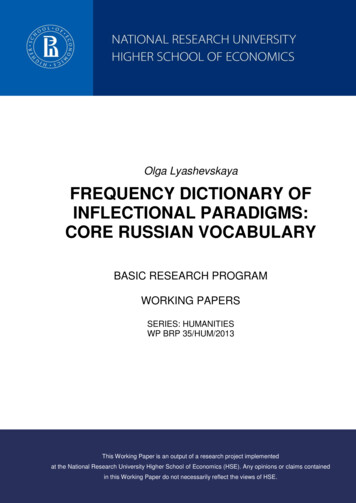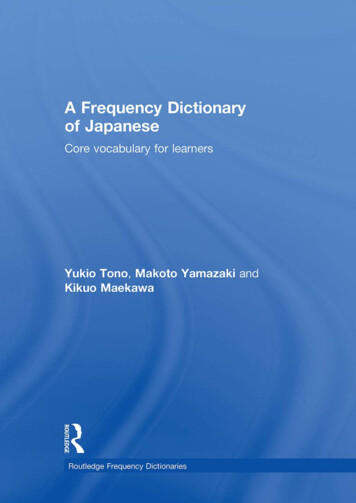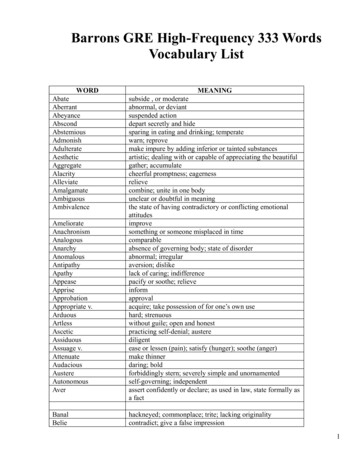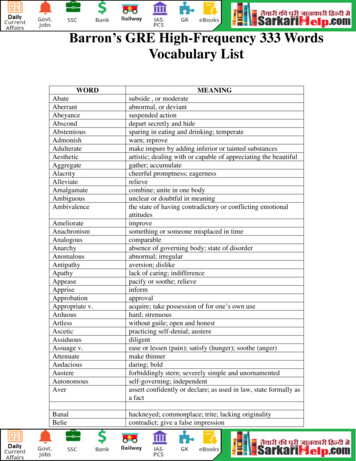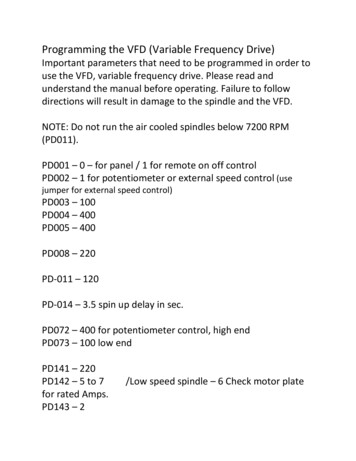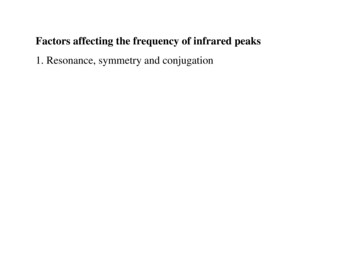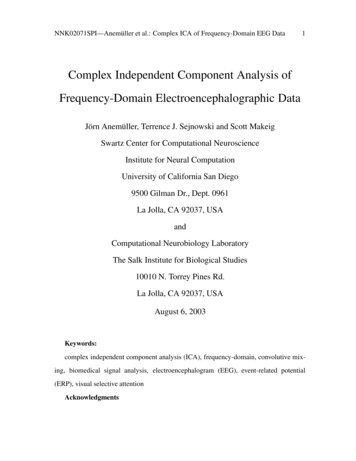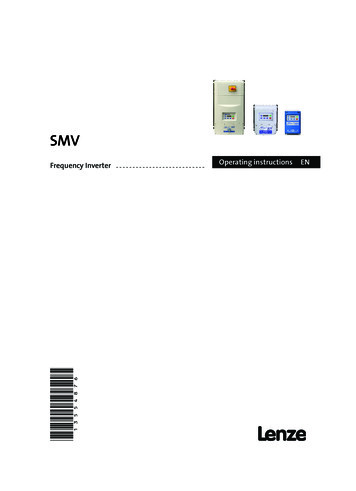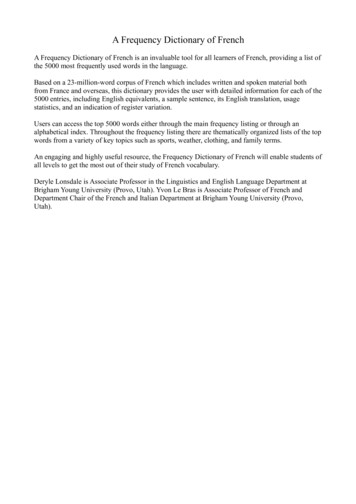
Transcription
A Frequency Dictionary of FrenchA Frequency Dictionary of French is an invaluable tool for all learners of French, providing a list ofthe 5000 most frequently used words in the language.Based on a 23-million-word corpus of French which includes written and spoken material bothfrom France and overseas, this dictionary provides the user with detailed information for each of the5000 entries, including English equivalents, a sample sentence, its English translation, usagestatistics, and an indication of register variation.Users can access the top 5000 words either through the main frequency listing or through analphabetical index. Throughout the frequency listing there are thematically organized lists of the topwords from a variety of key topics such as sports, weather, clothing, and family terms.An engaging and highly useful resource, the Frequency Dictionary of French will enable students ofall levels to get the most out of their study of French vocabulary.Deryle Lonsdale is Associate Professor in the Linguistics and English Language Department atBrigham Young University (Provo, Utah). Yvon Le Bras is Associate Professor of French andDepartment Chair of the French and Italian Department at Brigham Young University (Provo,Utah).
Page iiRoutledge Frequency DictionariesGeneral Editors:Paul Rayson, Lancaster University, UKMark Davies, Brigham Young University, USAEditorial Board:Michael Barlow, University of Auckland, New ZealandGeoffrey Leech, Lancaster University, UKBarbara Lewandowska-Tomaszczyk, University of Lodz, PolandJosef Schmied, Chemnitz University of Technology, GermanyAndrew Wilson, Lancaster University, UKAdam Kilgarriff, Lexicography MasterClass Ltd and University of Sussex, UKHongying Tao, University of California at Los AngelesChris Tribble, King’s College London, UKOther books in the series:A Frequency Dictionary of Mandarin ChineseA Frequency Dictionary of GermanA Frequency Dictionary of PortugueseA Frequency Dictionary of SpanishA Frequency Dictionary of Arabic (forthcoming)
Page iiiA Frequency Dictionary of FrenchCore vocabulary for learnersDeryle Lonsdale and Yvon Le BrasLONDON AND NEW YORK
Page ivFirst published 2009 by Routledge 2 Park Square, Milton Park, Abingdon, Oxon OX14 4RNSimultaneously published in the USA and Canada by Routledge 270 Madison Ave, New York, NY10016Routledge is an imprint of the Taylor & Francis Group, an informa businessThis edition published in the Taylor & Francis e-Library, 2008.To purchase your own copy of this or any of Taylor & Francis or Routledge’s collection ofthousands of eBooks please go to www.eBookstore.tandf.co.uk. 2009 Deryle Lonsdale and Yvon Le BrasAll rights reserved. No part of this book may be reprinted or reproduced or utilised in any form orby any electronic, mechanical, or other means, now known or hereafter invented, includingphotocopying and recording, or in any information storage or retrieval system, without permissionin writing from the publishers.British Library Cataloguing in Publication DataA catalogue record for this book is available fromthe British LibraryLibrary of Congress Cataloging in Publication DataLonsdale, Deryle. A frequency dictionary ofFrench : core vocabulary for learners / Deryle Lonsdale, Yvon Le Bras. p. cm. Includes index. 1.French language—Word frequency—Dictionaries. I. Lonsdale, Deryle. II. Title. PC2691.L66 2009443′.21—dc19 2008042400ISBN 0-203-88304-7 Master e-book ISBNISBN10:0-415-77531-0 (pbk)ISBN10:0-415-77530-2 (hbk)ISBN10:0-203-88304-7 (ebk)ISBN13:978-0-415-77531-1 (pbk)ISBN13:978-0-415-77530-4 (hbk)ISBN13:978-0-203-88304-4 (ebk)Page vContentsThematic vocabulary list viSeries preface viiAcknowledgments ixAbbreviations xIntroduction 1References 8Frequency index 9Alphabetical index 204Part of speech index 258
Page viThematic vocabulary lsTimeSportsNatural features and plantsWeatherProfessionsCreating nouns – 1RelationshipsNouns – differences across registersColorsOppositesNationalitiesCreating nouns – 2EmotionsAdjectives – differences across registersVerbs of movementVerbs of communicationUse of the pronoun “se”Verbs – differences across registersAdverbs – differences across registersWord 42149156163170178186195
Page viiSeries prefaceThere is a growing consensus that frequency information has a role to play in language learning.Data derived from corpora allows the frequency of individual words and phrases in a language to bedetermined. That information may then be incorporated into language learning. In this series, thefrequency of words in large corpora is presented to learners to allow them to use frequency as aguide in their learning. In providing such a resource, we are both bringing students closer to reallanguage (as opposed to textbook language, which often distorts the frequencies of features in alanguage, see Ljung 1990) and providing the possibility for students to use frequency as a guide forvocabulary learning. In addition we are providing information on differences between frequenciesin spoken and written language as well as, from time to time, frequencies specific to certain genres.Why should one do this? Nation (1990) has shown that the 4,000–5,000 most frequent wordsaccount for up to 95 per cent of a written text and the 1,000 most frequent words account for 85 percent of speech. While Nation’s results were for English, they do at least present the possibility that,by allowing frequency to be a general guide to vocabulary learning, one task facing learners – toacquire a lexicon which will serve them well on most occasions most of the time – could beachieved quite easily. While frequency alone may never act as the sole guide for a learner, it isnonetheless a very good guide, and one which may produce rapid results. In short, it seems rationalto prioritize learning the words one is likely to hear and use most often. That is the philosophybehind this series of dictionaries.The information in these dictionaries is presented in a number of formats to allow users to accessthe data in different ways. So, for example, if you would prefer not to simply drill down through theword frequency list, but would rather focus on verbs, the part of speech index will allow you tofocus on just the most frequent verbs. Given that verbs typically account for 20 per cent of all wordsin a language, this may be a good strategy. Also, a focus on function words may be equallyrewarding – 60 per cent of speech in English is composed of a mere 50 function words.We also hope that the series provides information of use to the language teacher. The idea thatfrequency information may have a role to play in syllabus design is not new (see, for example,Sinclair and Renouf 1988). However, to date it has been difficult for those teaching languages otherthan English to use frequency information in syllabus design because of a lack of data. WhileEnglish has long been well provided with such data, there has been a relative paucity of suchmaterial for other languages. This series aims to provide such information so that the benefits of theuse of frequency information in syllabus design can be explored for languages other than English.We are not claiming, of course, that frequency information should be used slavishly. It would be apity if teachers and students failed to notice important generalizations across the lexis presented inthese dictionaries. So, for example, where one pronoun is more frequent than another, it would beproblematic if a student felt they had learned all pronouns whenPage viiithey had learned only the most frequent pronoun. Our response to such issues in this series is toprovide indexes to the data from a number of perspectives. So, for example, a student workingdown the frequency list who encounters a pronoun can switch to the part of speech list to see whatother pronouns there are in the dictionary and what their frequencies are. In short, by using the listsin combination a student or teacher should be able to focus on specific words and groups of words.Such a use of the data presented here is to be encouraged.
Tony McEnery and Paul Rayson Lancaster, 2005ReferencesLjung, M. (1990)A Study of TEFL Vocabulary. Stockholm: Almqvist & Wiksell International.Nation, I.S.P. (1990)Teaching and Learning Vocabulary. Boston: Heinle and Heinle.Sinclair, J.M. and Renouf, A. (1988) “A Lexical Syllabus for Language Learning”. In R. Carter andM. McCarthy (eds) Vocabulary and Language Teaching London: Longman, pp. 140–158.
Page ixAcknowledgmentsWe are first and foremost grateful to Mark Davies for proposing that we undertake this work, andfor his occasional guidance and suggestions throughout its duration. This work also would not havebeen possible without the help of our able and hard-working student research assistants at BrighamYoung University: Fritz Abélard, Amy Berglund, Katharine Chamberlin, and Ben Sparks.The first author would like to thank his French instructors throughout his formative years,particularly France Levasseur-Ouimet and Gérard Guénette. He also acknowledges the inspiringinfluence of past colleagues in translation and lexicography including Greg Garner, Benoît Thouin,Brian Harris, Robert Good, Alain Danik, and Claude Bédard. He dedicates this book to his parents,to his wonderfully supportive wife Daniela, and to Walter H. Speidel whose own pioneering work incorpus-based computerized lexicography stands as an example for all of us who work in this field.The second author wishes to thank Philippe Hamon, Bernard Quemada, and Réal Ouellet, hisprofessors at the University of Rennes, the University of Paris III, and Laval University, whoinstilled in him the desire to study and teach the French language and literature. He dedicates thisbook to his parents and especially to his wife Hoa for her continued support and encouragement inhis professional endeavors.Page xAbbreviations Categories Exampleadjadvconjdetintjnnadjprepprovadjective1026 lourd adj heavyadverb1071 certainement adv certainlyconjunction 528 puisque conj sincedeterminer214 votre det yourinterjection889 euh intj er, um, uhnoun802 absence nf absencenoun/adjective 4614 insensén adj insanepreposition389 parmi prep amongpronoun522 lui-même pro himselfverb1014 confirmer v to confirmFeatures on culinepluralno distinct feminineno distinct plural1011 armée nf army1324 après-midi nmi afternoon707 signe nm sign3654 dépens nmpl expense3770 apte adj(f) capable3901 croix nf(pl) cross
Page 1IntroductionThe value of a frequency dictionary for FrenchToday French is the second most taught and widespread second language globally, behind English.Yet, surprisingly, there is no current corpus-based frequency dictionary of the French language. Thepresent dictionary is meant to address this shortcoming, and is part of a series that includes otherhighly useful dictionaries for Spanish (Davies, 2006) and Portuguese (Davies & Preto-Bay, 2008).As such it is similar in intent, approach, structure, and content to its predecessors. As noted below,some modifications have also been made to make it more usable for English speakers, who doconstitute the largest group of speakers on the planet.The purpose for this book is to prepare students of French for the words that they are most likely toencounter in the “real world”. It is meant to help alleviate the phenomenon encountered all too oftenin dictionaries and language primers where word lists are introduced based on intuitive orunverifiable notions of which words might conceivably be most useful for students to acquire, andin which order. The dictionary is designed primarily as a reference work which could be used inconcert with standard classroom curricular materials or used on an individual study basis. Ideas onhow to carry out this integration have been noted in the previous dictionaries noted above.Contents of the dictionaryThis is first and foremost a frequency dictionary. The principal information concerns the 5,000 mostfrequent words in French as determined in the process described below. This information isarranged in three different formats: (i) a main frequency listing, which begins with the mostfrequent word (with associated information) followed by the next most frequent word, and so forth;(ii) an alphabetical index of these words, and (iii) a frequency listing of the words organized by partof speech, and (iv) thematic lists grouping some of the words into related semantic classes. Each ofthe entries in the main frequency listing contains the word itself, its part(s) of speech (e.g. noun,verb, adjective, etc.), a context reflecting its actual usage previously in French, an Englishtranslation of that context, and summary statistical information about the usage of that word. Someor all of this information is likely to be highly useful for language learners in different settings.The vocabulary itself was derived from a corpus, or body, of French texts. The corpus we collectedwas assembled specifically for this work and totals millions of words, half of them reflectingtranscriptions of spoken French and the other half written French texts. Since the dictionary isfocused primarily on frequency and usage, the words do not have associated with them anypronunciation guides, etymological history, or domain-specific usage information. The dictionary isalso focused on single words, which is a crucial but not exclusive consideration in languagelearning; to extensively address fixed word expressions such as collocations and idioms would bebeyond the scope of this dictionary.The dictionary, then, is designed as an instrument for helping students acquire a core vocabulary ofFrench words in various ways, including based on their observed frequency in recent Frenchlanguage usage. The versatility in its organization should presuma
A Frequency Dictionary of French is an invaluable tool for all learners of French, providing a list of the 5000 most frequently used words in the language. t Based on a 23-million-word corpus of French which includes written and spoken material both from France and overseas, this dictionary provides the user with detailed information for each of the
